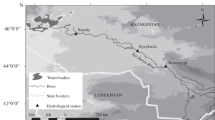Abstract
The regional features of transformation in the chemical composition of water in the Lower Volga tributaries and its main trends under anthropogenic impact and climatic variations are presented. Most trends for the principle ions (sulfates, carbonates, calcium and magnesium ions) are increasing, which may be a consequence of ongoing climate change. Moderate decreasing trends prevail in the concentrations of nutrients and organic substances in water. It was found that the trends in metal concentrations are multidirectional. All revealed statistically significant trends for iron and copper compounds are decreasing, and those for manganese are increasing. Based on the analysis of the identified trends in the chemical composition, the river ecosystems of the Lower Volga tributaries are classified into two categories: stable (“healthy”) and transformed (“transitioning”).
Similar content being viewed by others
REFERENCES
V. A. Bryzgalo, A. M. Nikanorov, and O. S. Reshetnyak, “Variability of Ecological Conditions in River Zones of Mouth Ecosystems of the Large Russian Rivers,” Voda: Khimiya i Ekologiya, No. 12 (2013) [in Russian].
State Water Register, http://textual.ru [in Russian] (Accessed June 10, 2021).
V. I. Danilov-Danil’yan, “National Priority Project “Rehabilitation of the Volga River”: The First Step to Normalization of Ecological Conditions in the River Basin,” in Scientific Problems of Rehabilitation of Russian Rivers and Possible Solutions (Studia F1, Moscow, 2019) [in Russian].
A. P. Demin, “Wastewater and Water Quality in the Volga River Basin (2000–2015),” Uchenye Zapiski RGGMU, No. 48 (2017) [in Russian].
Diagnostic Analysis of Environmental Conditions in the Arctic Zone of the Russian Federation (Extended Summary), Ed. by B. A. Morgunov (Nauchnyi Mir, Moscow, 2011) [in Russian].
Diffusive Pollution of Water Bodies: Problems and Solutions. Collected Monographs, Ed. by V. I. Danilov-Danil’yan (RAN, Moscow, 2020) [in Russian].
T. D. Zinchenko, V. K. Shitikov, L. V. Golovatyuk, V. I. Nomokonova, V. I. Popchenko, and E. V. Ambrosimova, “Ecosystem Approach to the Problem of Bioindication of the Middle and Lower Volga Basin Rivers,” Astrakhanskii Vestnik Ekologicheskogo Obrazovaniya, No. 1 (2014) [in Russian].
Catalog of Hydrological Observation Stations on the Russian Rivers, Issue 3 (Nizhny Novgorod, 2007) [in Russian].
Zh. V. Kuz’mina and S. E. Treshkin, “Climate Change in the Lower Volga Basin,” Aridnye Ekosistemy, No. 3, 20 (2014) [in Russian].
P. N. Makkaveev, “Dissolved Inorganic Carbon in the Ocean and the Climate,” Geologiya. Inzhenernaya Geologiya. Gidrogeologiya. Geokriologiya, No. 3 (2012) [in Russian].
T. I. Moiseenko and M. I. Dinu, “The Phenomenon of Increase in the Organic Acid Content in Natural Waters and Its Influence on Water Acidification,” Dokl. Akad. Nauk, No. 5, 460 (2015) [Dokl. Earth Sci., No. 2, 460 (2015)].
A. M. Nikanorov, V. A. Bryzgalo, L. S. Kosmenko, M. Yu. Kondakova, and O. S. Reshetnyak, “A Role of River Inflow of Dissolved Chemicals in Anthropogenic Transformation of Water Environment Status in the Volga Mouth Region,” Voda: Khimiya i Ekologiya, No. 7 (2010) [in Russian].
A. M. Nikanorov, V. A. Bryzgalo, and O. S. Reshetnyak, Russian Rivers under Conditions of Ecological Emergencies (NOK, Rostov-on-Don, 2012) [in Russian].
V. N. Reshetnyak, K. G. Myagkova, and O. S. Reshetnyak, “Regional Features of Chemical Composition and Pollution Level of Water in the Lower Volga Basin,” in Ecological Collection 7. Trans. Young Scientists, Ed. by S. A. Senator, O. V. Mukhortova, and S. V. Saksonov (2019).
O. S. Reshetnyak, “Features of Extremely High Level of Water Contamination in the Lower Volga Ecosystems,” Samarskaya Luka: Problemy Regional’noi i Global’noi Ekologii, No. 2, 23 (2014) [in Russian].
O. S. Reshetnyak, “Evaluating Anthropogenic Impact and Ecological Risk in the Lower Volga Ecosystem,” Trudy Instituta Biologii Vnutrennikh Vod im. I. D. Papanina RAN, No. 83 (2018) [in Russian].
O. S. Reshetnyak, A. M. Nikanorov, V. A. Bryzgalo, and L. S. Kosmenko, “Anthropogenic Transformation of the Aquatic Ecosystem of the Lower Volga,” Vodnye Resursy, No. 6, 40 (2013) [Water Resour., No. 6, 40 (2013)].
N. E. Dobiesz, R. E. Hecky, T. B. Johnson, J. Sarvala, J. M. Dettmers, M. Lehtiniemi, L. G. Rudstam, C. P. Madenjian, and F. Witte, “Metrics of Ecosystem Status for Large Aquatic Systems—A Global Comparison,” J. Great Lakes Res., 36 (2010).
G. O. Lehn, A. D. Jacobson, T. A. Douglas, J. W. McClelland, A. J. Barker, and M. S. Khosh, “Constraining Seasonal Active Layer Dynamics and Chemical Weathering Reactions Occurring in North Slope Alaskan Watersheds with Major Ion and Isotope (\(\delta ^{34}\mathrm{S}_\mathrm{SO4}\), \(\delta ^{13}\mathrm{C}_\mathrm{DIC}\), \({}^{87}\mathrm{Sr}/{}^{86}\mathrm{Sr}\), \(\delta^{44/40}~\mathrm{Ca}\), and \(\delta^{44/42}~\mathrm{Ca}\)) Measurements,” Geochim. Cosmochim. Acta, 217 (2017).
Author information
Authors and Affiliations
Corresponding author
Additional information
Translated from Meteorologiya i Gidrologiya, 2022, No. 1, pp. 95-104. https://doi.org/10.52002/0130-2906-2022-1-95-104.
About this article
Cite this article
Reshetnyak, O.S., Kosmenko, L.S. & Danilenko, A.O. Trends in the Variability of the Chemical Composition and Quality of Water in the Lower Volga Tributaries under Anthropogenic Impact and Climate Change. Russ. Meteorol. Hydrol. 47, 67–73 (2022). https://doi.org/10.3103/S1068373922010083
Received:
Revised:
Accepted:
Published:
Issue Date:
DOI: https://doi.org/10.3103/S1068373922010083




